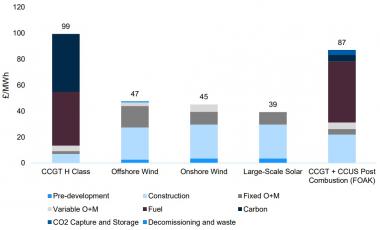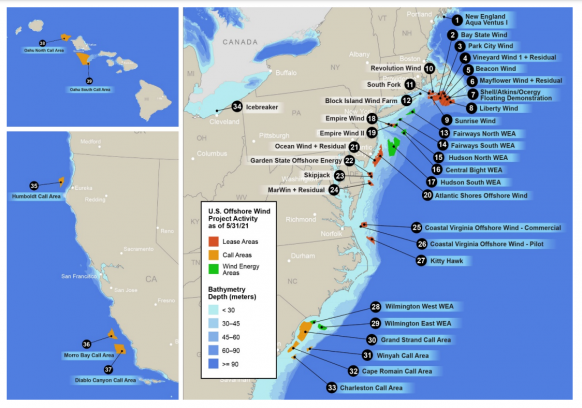UK hikes offshore wind target to 50 GW; Offshore wind competitive in Delaware
The wind power news you need to know.

Related Articles
UK raises offshore wind target, rejects onshore wind push
The UK government has raised its offshore wind target by 10 GW to 50 GW by 2030 and pledged faster onshore wind and solar build in a new energy security strategy announced April 7.
Boris Johnson's government also plans to approve a new fleet of nuclear power plants as it looks to curb the UK's reliance on imported gas and stabilise soaring wholesale energy prices. Gas-fired plants currently generate around 40% of the UK's electricity and the government will launch new oil and gas licensing rounds in the UK North Sea, it said.
The government failed to set specific targets for onshore wind and solar power, rejecting proposals by the energy ministry.
The UK was already leading Europe on offshore wind build. To accelerate deployment, the government will introduce a range of measures aimed at shortening the approval process from four years to one year. Auctions for contract for difference (CFD) subsidies will be held every year, rather than every two years under the current process, it said.
To meet its aim, the government raised its floating wind target from 1 GW to 5 GW. Industry experts had already said the previous target was too low and in January Scotland allocated 15 GW of floating wind projects, putting the UK at the forefront of floating wind development.
Forecast UK power generation costs in 2030
(Click image to enlarge)
Source: UK government, August 2020
Far less support was offered to onshore wind projects and large-scale solar, which have faced opposition from members of Johnson's Conservative party and local groups.
Last year, the government reopened auctions for contract for difference (CFD) subsidies to onshore wind and solar following a five-year moratorium imposed by the previous Conservative government. The UK currently hosts around 14 GW of onshore wind and 14 GW of solar.
The government will not streamline planning regulations for onshore wind and will consult on new projects with a limited number of supportive communities, it said in its energy security statement. The government will look at providing support for repowering of existing onshore wind sites, it said.
For solar, the government pledged a "five-fold increase in deployment by 2035" and will simplify planning processes for rooftop solar, lower financing costs and consult on supportive amendments to planning rules for larger projects, it said.
Portugal hikes renewable energy target to 80% by 2026
Portugal will accelerate wind and solar build to achieve 80% of electricity from renewable energy by 2026, four years earlier than previously planned, the government announced April 1.
Portugal already gets 60% of its power from renewables but European Union (EU) members are accelerating renewables to mitigate growing energy supply risks following Russia's invasion of Ukraine.
The European Union (EU) plans to cut its dependence on Russian gas supplies by two thirds by the end of the year end it entirely by 2027 and will study new policies that accelerate renewable energy, the European Commission (EC) said last month. Germany has pledged to fast-track the implementation of new energy laws that accelerate wind and solar deployment and Portugal's neighbour Spain has approved an accelerated permitting procedure for solar projects of up to 150 MW in a suite of energy transition measures, according to media reports.
"Portugal has already taken very significant measures in the energy transition, but the evolution and duration of the war in Ukraine must necessarily imply new measures," Portuguese Cabinet Minister Mariana Vieira da Silva told a news conference.
Portugal currently has 7.3 GW of hydroelectric capacity, 5.6 GW of onshore wind and 2 GW of solar power.
The government plans to allocate 3 to 4 GW of floating wind projects this summer in its first commercial-scale auction, Environment and Energy Transition minister Joao Matos Fernandes told Reuters last month.
The projects will be due online around 2026, Matos Fernandes said in an interview.
Portugal also recently launched Europe's largest auction of floating solar capacity. The government will allocate 263 MW of capacity at seven hydroelectric dams, Reuters reported.
Offshore wind competitive in Delaware, study shows
Offshore wind farms in Delaware could supply power at a similar cost to current wholesale levels, according to a new report by researchers at the University of Delaware.
The cost estimate is based on an 800 MW offshore wind project and three of these could provide power for the entire state.
Offshore wind activity is spreading up and down the U.S. East Coast but Delaware is yet to launch its own program. The state currently gets almost all its power from gas-fired generation.
US offshore wind development, lease areas
(Click image to enlarge)
Source: U.S. Department of Energy's Offshore Wind Market Report (2021)
The study was conducted by the University of Delaware's Special Initiative on Offshore Wind (SIOW) and used learnings from new regulation and offshore wind contracts in New York and Massachusetts.
Delaware could further reduce offshore wind power prices by introducing a renewable energy credit scheme for utilities and refining permitting rules to avoid costly delays, the researchers said
Lawmakers may need to change regulation to incentivise utilities to secure long-term offshore wind contracts rather than short-term gas plant deals, they said.
Offshore wind developers seek long-term offtake contracts or government subsidies to mitigate revenue risks and secure competitive financing.
“The whole system is geared for fossil fuel or a nuclear supplier, not for wind power or any big, renewable energy project,” Willett Kempton, professor of marine sciences and co-author of the report, said. “So adjustments to rules and law would make this happen in the most cost-effective way.”
In the long term, Delaware could build extra offshore wind capacity to produce green hydrogen for transport fuels and chemical feedstocks, the report said.
Reuters Events


